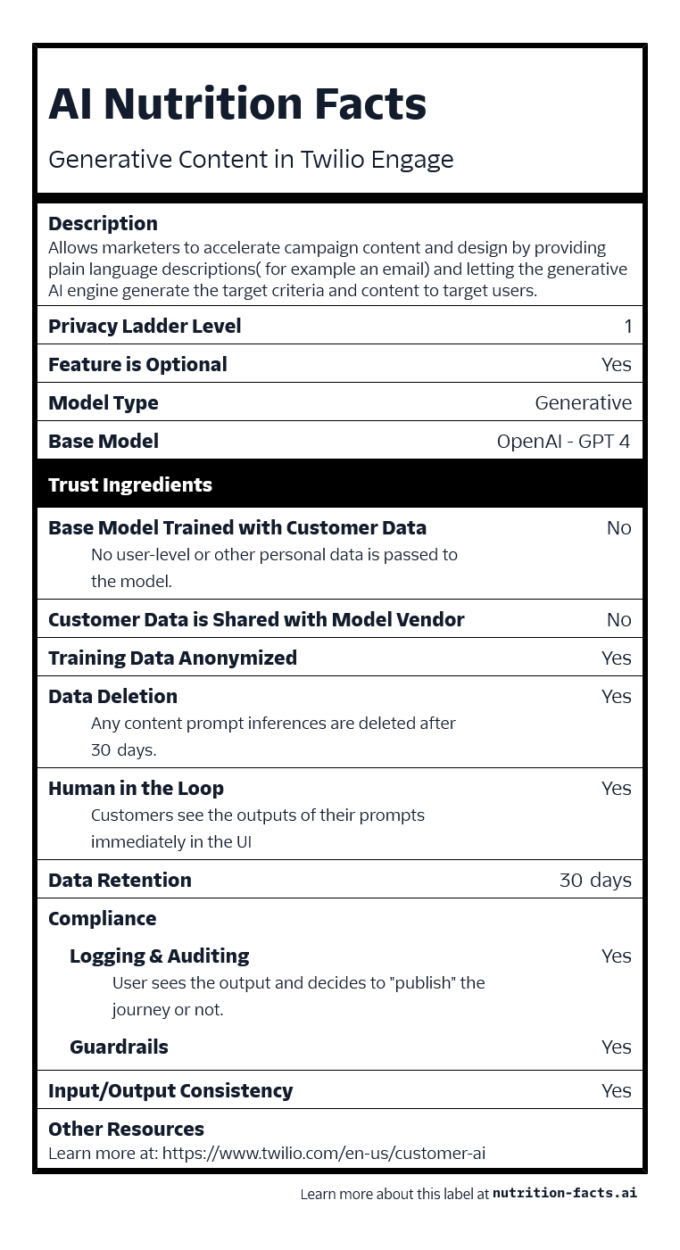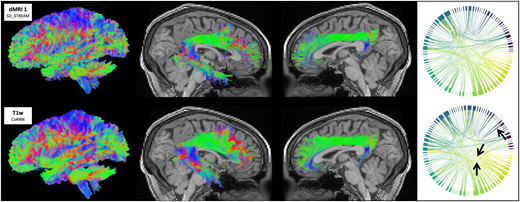Introduction Deep learning is an advanced machine learning technique based on artificial neural networks inspired by a human brain, especially featuring the capability to automatically extract complex patterns of data by multi-layer neural networks [1,2]. The neural network consists of input, hidden, and output layers. Unlike conventional machine learning algorithms, deep learning architectures have multiple

AI Nutrition Labels – A Food-Inspired Approach To Trust – I by IMD

Artificial Intelligence
To build trust, companies should be as transparent with their algorithms as they are with their ingredients.
How well do your employees or customers understand the AI systems your company is building? If you’re like most business leaders, the honest answer is not well enough. And that’s a growing problem. As AI becomes more deeply embedded in everyday tools and decisions, public skepticism is rising. In a global survey across 17 countries, KPMG found that six in 10 people expressed concern about the use of AI. A separate study by Cognizant revealed that nearly half of those reluctant to use AI for everyday activities cited concerns around accuracy, intent, and data security.
To address these concerns, one surprisingly effective and accessible solution may come from an unexpected place: the food industry. Just as nutrition labels give consumers a clearer picture of what they are consuming, AI “nutrition labels” could help non-technical users better understand, assess, and trust the AI systems they interact with.
A 2021 study confirmed that packaging labels highlighting ingredients, origins, and certifications were the most tangible source of trust for consumers.
What food can teach tech
The food industry didn’t always offer transparency. But decades of consumer advocacy led to standardized labels that now play a key role in building trust and driving better choices. A 2020 study revealed that 69% of consumers were willing to pay more for products with recognizable quality and safety standards or certifications. A 2021 study confirmed that packaging labels highlighting ingredients, origins, and certifications were the most tangible source of trust for consumers.
The same principle can apply to AI. Nutrition label-inspired tools are emerging to explain the components of AI systems, but most are aimed at developers and data scientists. The Dataset Nutrition Label, for example, helps data scientists identify potential bias in datasets. NVIDIA has created the Model Card++, a template for explaining how machine learning models function, while IBM is developing AI Factsheets that provide plain -language descriptions of deep learning systems. However, these initiatives still assume some degree of technical fluency.
What would it look like to design AI explanations as clearly as a food label for users who aren’t AI experts but need to understand enough to make informed decisions? One company experimenting exactly that is Twilio.

“Customer response has been positive, especially among developers and business leaders who are just beginning to explore Twilio’s products.”
Twilio’s AI Nutrition label: A front door to trust
Twilio, the cloud communications platform known for enabling personalized messaging across voice, text, and digital channels, has taken a proactive and pragmatic approach to AI transparency. In mid-2023, the company launched its AI Nutrition Facts Label to explain how Twilio products use generative AI. With over 300,000 customers, from startups to large enterprises, Twilio needed a way to clearly communicate with both technical and non-technical users, consistent with its ethos of transparency, responsibility, and accountability. “Model cards are great,” noted Kat McCormick Sweeney, Director, Emerging Technology & Innovation, who led Twilio’s nutrition label initiative. “But they still felt suited to technical audiences. The nutrition label metaphor just resonated more with our broad customer base.”
Crucially, the label is more than a communication tool; it’s a formal output embedded in the product development lifecycle. Any Twilio product using generative AI must include a completed nutrition label after passing the pilot stage to move forward. This makes labelling a standard development checkpoint, not an afterthought. The label itself includes information Twilio considers most important, based on its dual perspective as both a buyer of AI tools and a builder of AI-powered products. It outlines which large language models are used, how customer data is handled, what limitations exist, and how the AI system is designed to behave (see Figure 1 for an example).
Customer response has been positive, especially among developers and business leaders who are just beginning to explore Twilio’s products. The label is typically introduced early in the engagement process, serving as a starting point to proactively communicate Twilio’s use of generative AI, well before more detailed technical or privacy reviews take place. In an unexpected twist, the label has also gained traction beyond Twilio. Released as an open-source initiative, Twilio’s AI Nutrition Label has been downloaded by developers, educators, and others, like the San Francisco Exploratorium, seeking to educate non-technical audiences about their use of AI.
For Twilio, the nutrition label is more than a compliance tool; it’s a conversation starter, a symbol of intent, and a step toward industry-wide transparency. “We’re still in learning mode as we review which information is most relevant to our customers as AI systems evolve,” Sweeney noted. “But we want to help shape this space by doing the right thing.”

Consistency matters
When it comes to AI nutrition labels, one challenge will be reaching consensus on their form and content. In the food industry, nutrition labels work because regulators are clear on the requirements, making it easier for consumers to understand the labels and use them to compare products.
Several organizations are now striving for standardization and consistency of AI nutrition labels. Open Ethics has developed the Open Ethics Label, which it suggests can help organizations signal a commitment to transparency. Its label includes details such as a systemic approach to algorithmic and data transparency, as well as the precautions that the organization takes when modulating the system’s output. Earlier this year, the US-based Coalition for Health AI (CHAI) shared its draft model card, drafted in collaboration with organizations from both private and public sectors, including health systems, insurers, and health tech companies.
If successful, these efforts could help establish a common language for AI transparency, one that empowers non-technical users to make informed decisions and builds trust across the ecosystem. Just as standardized food labels reshaped consumer expectations, consistent AI labeling has the potential to raise the bar for accountability, not just within organizations but across industries. While the concept of AI nutrition labels is still evolving, that’s no reason to wait. Early adoption can offer immediate benefits and help shape the standards that are yet to be finalized.
Just as food labels reshaped how we think about what we eat, AI nutrition labels could redefine how we evaluate and engage with this new technology.
Making AI nutrition labels part of your strategy
Labeling can help companies stay ahead of evolving compliance standards and foster better alignment across internal teams. The EU AI Act, passed in 2024, includes transparency and risk-classification requirements for many AI systems. AI nutrition labels could serve as a low-friction way to meet these obligations. Early adoption allows organizations to signal responsible innovation, not because they have to but because they choose to. That mindset benefits everyone. The very act of labelling, of clearly explaining how an AI system works in clear terms, compels teams to clarify assumptions, highlight safeguards, and acknowledge limitations. This process helps to crystallize what’s needed to build safer technology.
AI nutrition labels aren’t just technical artifacts. They’re strategic tools. In a landscape where AI accountability is under scrutiny, transparency can become a powerful differentiator.
If you’re deploying or evaluating AI tools, ask your team:
- Is the provenance of the base model clear?
- Was the data in the model ethically sourced?
- To what extent are there biases in the model data?
- Do we understand the known risks and how to mitigate them?
- Would a non-technical user feel informed or confused?
If the answers aren’t clear, a label could help both users and internal teams to surface the right conversations internally. For those unsure how to begin, the key is to think like a communicator, not a technologist. Start by identifying the core questions a non-technical user might ask: What does this AI system do? What data does it use? What are its known limitations? Then, answer them in plain language. Collaborate across technical, product, and communications teams to draft a simple, one-page label – just enough to demystify how the system works and what users can expect. Even a rough draft can surface misalignments or blind spots internally. Over time, labels can evolve into strategic tools, but the first step is simply making the invisible more visible.
Labeling AI won’t solve every challenge. But it’s a practical and symbolic step: a public commitment to transparency, responsibility, and trust. Just as food labels reshaped how we think about what we eat, AI nutrition labels could redefine how we evaluate and engage with this new technology.
All views expressed herein are those of the author and have been specifically developed and published in accordance with the principles of academic freedom. As such, such views are not necessarily held or endorsed by TONOMUS or its affiliates.
Authors

Tomoko Yokoi
Researcher, TONOMUS Global Center for Digital and AI Transformation
Tomoko Yokoi is an IMD researcher and senior business executive with expertise in digital business transformations, women in tech, and digital innovation. With 20 years of experience in B2B and B2C industries, her insights are regularly published in outlets such as Forbes and MIT Sloan Management Review.

Michael R. Wade
TONOMUS Professor of Strategy and Digital
Related

How human-AI synergy put Formula 1 on the fast track to success
July 25, 2025 • by Konstantinos Trantopoulos , Paolo Aversa in Artificial Intelligence
In Formula 1 racing, every microsecond counts. Konstantinos Trantopoulos and Paolo Aversa explore how teams use Human-AI collaboration to boost performance – and what businesses in other sectors can learn from their…

Four questions to guide the implementation of responsible AI
July 25, 2025 • by Faisal Hoque, Pranay Sanklecha, Paul Scade in Artificial Intelligence
As AI races ahead and regulators fall behind, the real question isn’t what your system can do, but what kind of organization you become by deploying it. Answering these four questions will…

From ideas to execution: using strategic enterprise architecture for AI value creation
July 16, 2025 • by Faisal Hoque in Artificial Intelligence
AI won’t contribute to a thriving business unless it’s hardwired into your purpose, people, processes, and architecture. Here’s how getting that alignment right can ensure maximum value from AI investments. …

Strategic use of AI in healthcare and pharma drives market advantage. Here’s how
July 10, 2025 • by Tomoko Yokoi, Michael R. Wade in Artificial Intelligence
The healthcare and pharmaceutical sectors are experiencing radical evolution through artificial intelligence, driving competition, and improving clinical outcomes. IMD’s AI Maturity Index highlights effective approaches from industry frontrunners like Bayer, Medtronic, and…
Learn Brain Circuits
Join us for daily exercises focusing on issues from team building to developing an actionable sustainability plan to personal development. Go on – they only take five minutes.
Read more
Explore Leadership
What makes a great leader? Do you need charisma? How do you inspire your team? Our experts offer actionable insights through first-person narratives, behind-the-scenes interviews and The Help Desk.
Read more
Join Membership
Log in here to join in the conversation with the I by IMD community. Your subscription grants you access to the quarterly magazine plus daily articles, videos, podcasts and learning exercises.
Sign up



